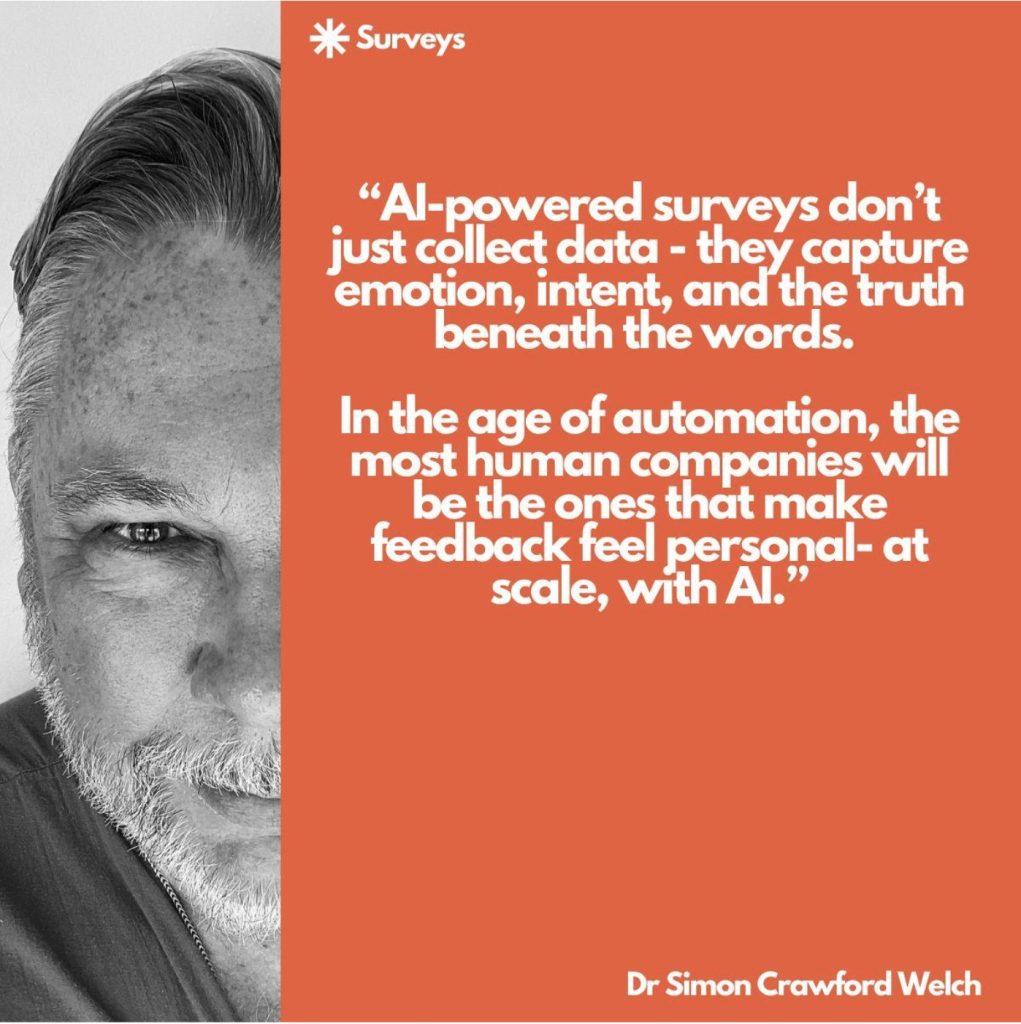From Forms to Conversations: How AI Chatbots Are Revolutionizing Survey Design
By
Simon Crawford Welch, PhD

There’s a quiet revolution happening in the world of survey design – and it sounds less like a checklist and more like a conversation.
If you’ve ever filled out a traditional survey – rigid, repetitive, and time-consuming – you know the feeling: mechanical, transactional, and easy to abandon halfway through. Now imagine that same feedback experience delivered through a friendly, intelligent, back-and-forth dialogue – more human, more dynamic, and more engaging.
Welcome to the age of AI-powered conversational surveys.
Driven by natural language processing (NLP), sentiment analysis, and machine learning, these chat-based surveys are making feedback more interactive, more personalized, and far more powerful. And in a world where customer and employee attention spans are shrinking fast, this shift couldn’t come at a better time.
Traditional Surveys Are Failing Modern Users
Before diving into what AI is doing right, let’s understand what traditional surveys get wrong.
- They’re impersonal. Everyone gets the same static set of questions, regardless of relevance.
- They’re fatiguing. Long, linear formats lead to high abandonment rates.
- They’re cold. There’s no sense of being heard – just a box to tick.
The result? Dismal engagement.
According to SurveyMonkey, the average survey completion rate across industries is 33%. For internal employee surveys, it’s often under 30%. And even when people do complete them, responses are often rushed, incomplete, or overly safe.
In a feedback economy, that’s a crisis. Organizations are spending millions trying to measure engagement, retention, and customer satisfaction – yet the tools we’ve been using to do it are outdated and outmatched.
Enter Conversational AI: Surveys That Talk With You
Unlike static surveys, AI-powered conversational surveys feel more like a chat with a curious, empathetic interviewer. Think: WhatsApp or Slack-style interaction, guided by an intelligent bot that can tailor follow-ups based on what you say.
They ask questions like:
- “Tell me a bit about how your week’s going.”
- “You mentioned team stress—can you expand on that?”
- “What would make this product more useful for you?”
And they do this while adjusting tone, language, and pacing to fit the respondent’s mood and behavior.
These AI bots don’t just gather data – they listen. And they learn from it.
“Conversational surveys create a feedback loop that’s continuous, adaptive, and emotionally intelligent,” says Natalie Anderson, Head of People Analytics at InsightLoop. “They’ve allowed us to 4x our survey engagement and cut down response fatigue dramatically.”
Why Conversational Surveys Work So Well
1. They Feel Human
Powered by natural language processing (NLP), AI bots can interpret tone, pick up on keywords, and mimic natural conversation. This makes the user feel like they’re talking with someone, not filling out a form.
In a recent study by Drift and SurveyMonkey, 70% of users said they preferred chat-based survey experiences over traditional forms – especially when accessed on mobile.
2. They’re Context-Aware
Unlike static surveys that assume every respondent is the same, conversational bots can ask tailored follow-ups in real time. If a user mentions “burnout,” the bot can instantly shift the conversation toward workload, manager support, or wellness.
This adaptive logic leads to richer insights – and makes the respondent feel heard.
3. They Boost Response Rates
Conversational surveys drastically increase participation. A 2023 study by Forrester Research found that conversational surveys had a completion rate 2.4x higher than static web surveys in the same context.
The same study showed that the average completion time was 30% faster – despite higher engagement and deeper responses.
4. They Drive Actionable Intelligence
AI doesn’t just collect responses. It analyzes them in real time. Advanced systems use sentiment analysis and intent detection to surface patterns like employee frustration, customer confusion, or unmet expectations – before they snowball into churn or attrition.
With traditional surveys, leaders often wait weeks for someone to interpret the data. With conversational surveys, real-time dashboards highlight themes and red flags immediately.
Real-World Use Cases
Employee Engagement
Companies like CultureAmp and Peachy Mondays are using AI bots to conduct weekly pulse checks that go far beyond “How satisfied are you at work?”
Instead, they ask things like: “Anything your manager did this week that made your work easier?”, “What could we improve in the next sprint?”
Responses are categorized instantly, routed to HR teams, and often followed up with personalized nudges or thank-you messages.
Customer Feedback
E-commerce brands are using conversational surveys post-purchase to gather product insights, delivery feedback, and customer sentiment.
Instead of a 10-question form, they ask: “How did everything go with your order?”, “Was there anything we could’ve done better?”
Open-ended replies are sorted by AI into actionable tags (e.g., “shipping delay,” “packaging damage,” “love the product”), helping CX teams prioritize issues faster.
Event & Experience Evaluation
Glamping resorts, luxury retreats, and hospitality brands (like Bolt Farm!) are beginning to use chat-based surveys to gather post-stay feedback in a format that feels more like a natural check-in than a corporate form.
The result? Guests are more honest, more detailed – and far more likely to recommend the experience.
The Human + AI Future of Feedback
Now, let’s be clear: AI surveys don’t replace human feedback loops – they enhance them.
When designed well, they:
- Capture honest insights earlier
- Surface real-time red flags
- Reduce survey fatigue
- Show respondents their voice matters
And because they feel personal and intuitive, they build trust. Employees are more likely to share when they feel safe. Customers are more likely to be loyal when they feel heard.
That’s emotional intelligence – at scale.
“In a world where people crave authenticity, AI-powered conversations don’t need to be perfect—they just need to be present, responsive, and respectful.” – Maya Collins, Chief Experience Officer, LoopAI
Feedback Is No Longer a Form—It’s a Conversation
Organizations that cling to rigid, outdated surveys will be left guessing. Those that embrace conversational feedback design, powered by AI, will not only gather more responses – they’ll understand them.
And that understanding becomes a competitive advantage: in retaining talent, delighting customers, and evolving faster than the rest.
Because in today’s world, the best insight doesn’t come from asking more questions.
It comes from asking them better – and listening like you mean it.
Simon Crawford-Welch, PhD, is the Founder, The Critical Thought Lab. Author of “American Chasms: Essays on the Divided States of America” & “The Wisdom of Pooh: Timeless Insights for Success & Happiness” (Available on Amazon) www.linkedin.com/in/simoncrawfordwelch



